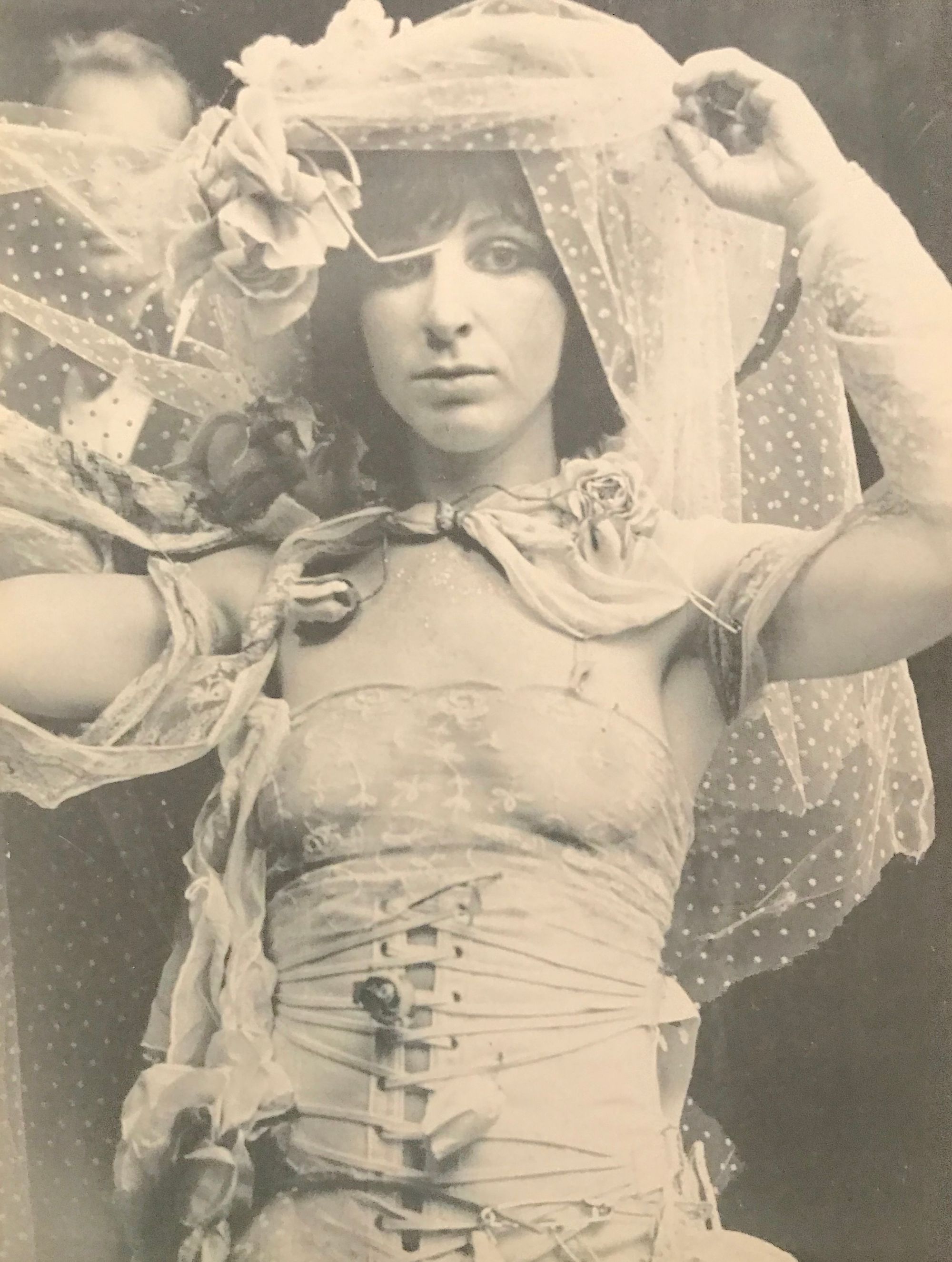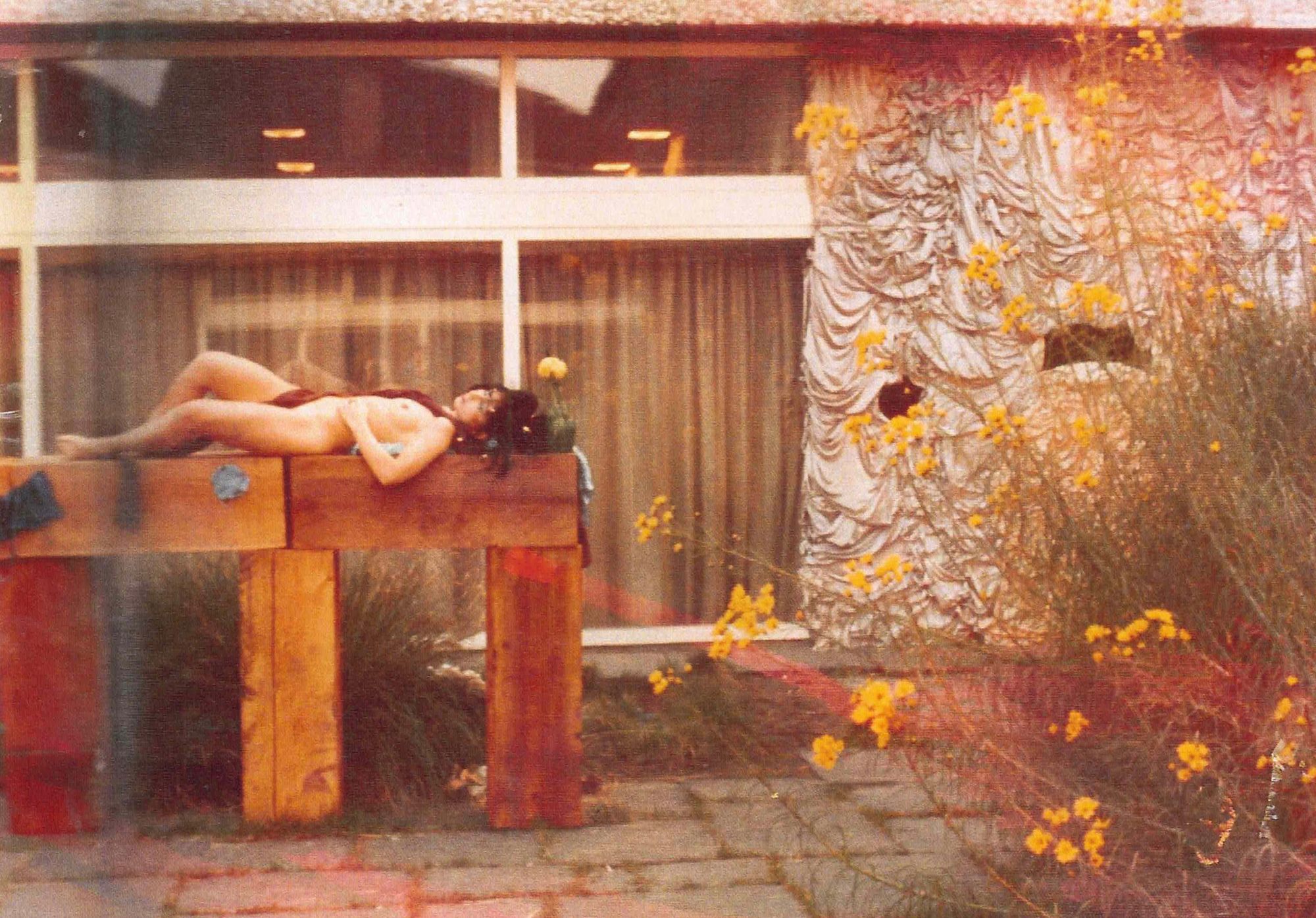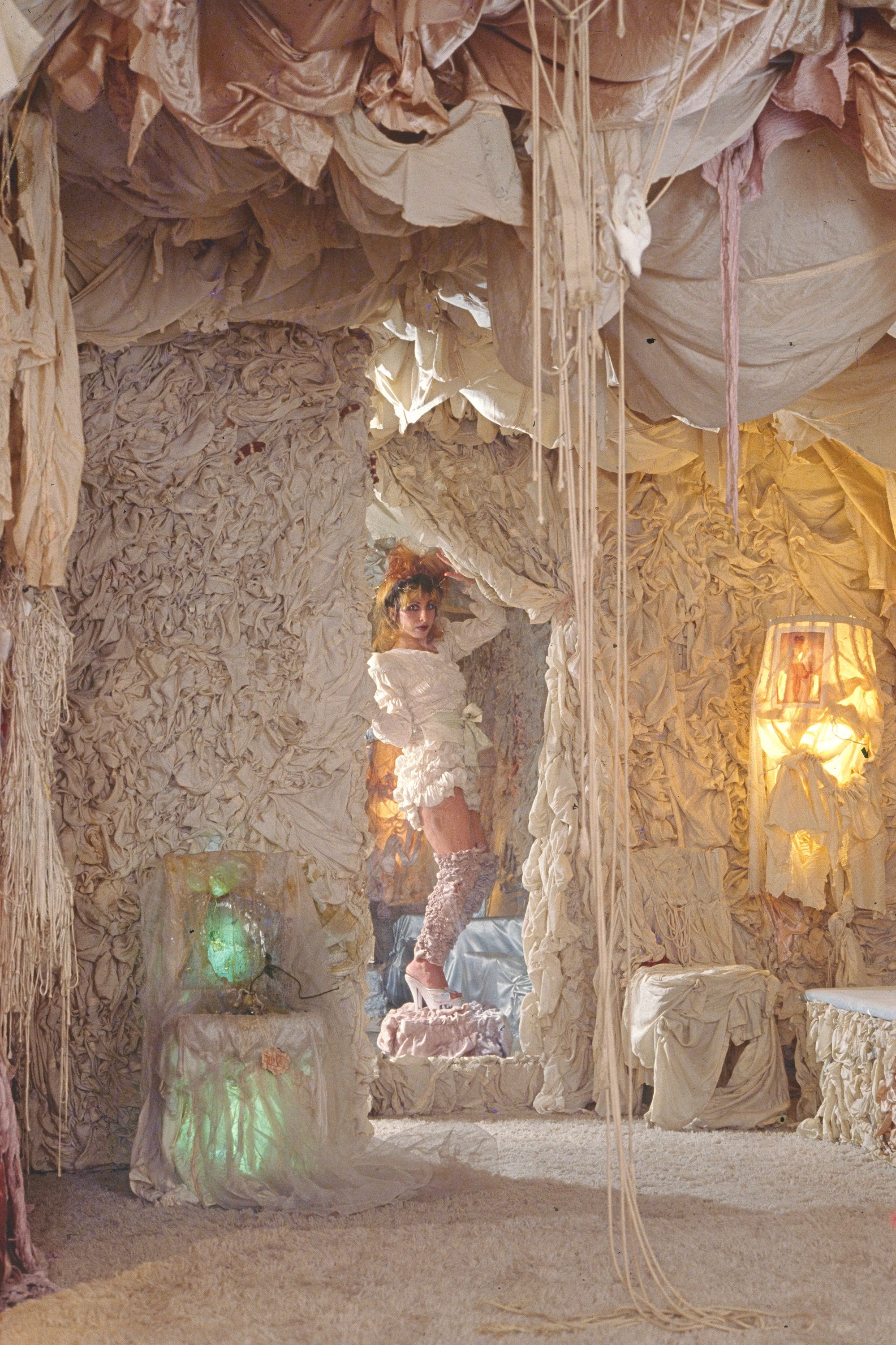Waking Dreams: Colette's Performance Art
Colette, The Last Stitch, 26 January 1978, performance within the installation Out of My House, a reconstruction of a section of Colette’s dining room area—as it was in 1978—of her continuously transforming Living Environment (1973–1982), for the Whitney Museum of Art Downtown Branch exhibition Out of the House, 26 January to 1 March 1978.
"I create a landscape... and become a part of it." — Colette
On December 2nd, 1975, the owners of the Rizzoli Bookstore in New York’s SoHo neighborhood organized an exhibition—something the store had never done—called “Fashion as Fantasy,” into which they poured their money and their hopes. Andy Warhol was involved as the lead artist, and the bookstore hoped the crossover glamor of high art and high fashion would generate both spectacle and sales. The opening night was a scene, with patrons and participants vying for the press’s (and each other’s) attention. The chaos of the opening was also the backdrop for a performance by the Tunisian-born, French artist Colette. She had originally been given a space to create one of her performance environments made of floor-to-ceiling ruched parachute fabric. At the last minute, however, the organizers gave Karl Lagerfeld her space. So, for the opening, Colette dressed as a “Ragdoll.” She wore Victorian laced boots, a hat, and gloves, as well as an orthopedic corset she had acquired second hand on Canal Street—a style that she would come to extend to her day-to-day life. With her Victoriana, she was steampunk before there was steampunk. Heavy eyeliner and red lips completed the exaggeratedly feminine image of a child’s doll come to life as an adult. She later recalled to me that she was left “a poor little rag doll, without an So she created one, expanding upon her planned performance by seizing space in the store’s display windows, aisles, and corners. In these spaces she performed sleeping, giving her the appearance of an abandoned child’s toy.

Colette, Rag Doll (for Rizzoli’s Fashion as Fantasy exhibition), 1975.
Photo: Rose Hartman.Since she started making work in the early ’70s, Colette has constantly reinvented herself. She began as a painter, but quickly realized that she wanted to exceed the bounds of the canvas. Her work since has mixed art and life, moving her visions into public. She was an early practitioner of the street art and performance that flourished in New York in the decade, making rogue, early-morning paintings of cryptic symbols on streets and sidewalks. She would come to be an installation artist, fashion designer, and leader of a rock band that played in the downtown music scene. Her retracted Rizzoli installation was part of the practice that made her legendary in the New York art world of the ’70s—lush, immersive environments of parachute satin and other soft fabrics in which she would do endurance performances of sleeping and dreaming. Her room-scale works were not just seen in galleries and museums. She also turned her apartment into an ongoing installation in which the boundaries between art, dress, and life were porous. She has transformed herself many times and had many names: Colette, Justine, Lumière, Mata Hari, Countess Reichenbach, Olympia, and Colette de la Victoire, among others. Each of her new identities has offered both an infiltration and a critique of the systems of value, fame, commodity, and art—always pushing the boundaries of what art might be and what we might expect it to look like.
With its metamorphoses and extensions, Colette’s work resists being told as a linear story. I first recognized its unbounded complexity while researching an exhibition of the little-known street artist and genderqueer provocateur Stephen Varble, who—unlike Colette—wasn’t invited to the “Fashion as Fantasy” party. Rather, he crashed it wearing a quilted, gender-confounding “Piggy Bank Dress” and was allowed entry only after spilling hundreds of pennies from the costume’s insides. I began interviewing Colette, whose recollections of that night and Varble’s rogue intervention were crucial to my research on the larger story of performance, fashion, and art in the 1970s. Through our ongoing correspondence, I’ve come to know just how rumbustious and rich her lifeworks have been. Each conversation reveals another layer of her ambitious and unruly practice of art and life. What I write here is less than the tip of the iceberg.
*
From the beginning, Colette has adopted starring roles, for which she creates sets that blur distinctions—not just between artist and character but also between the character’s stage and our shared environment. Throughout the ’70s, Colette’s work took as a core theme the critique of art history’s idealized images of passive women. Oppositionally, she became Persephone; the reclining Madame Récamier immortalized in the painting by Jacques-Louis David; Ophelia; or the stereotypical femme fatale. Colette’s first tableau performance, Homage to Delacroix (1970/1972), conjured from Delacroix’s iconic painting Liberty Leading the People (1830) a living, breathing heroine with defiant power. From there, she became more ambitious with her installations as the settings for these performance recreations from the history of art. Foundational was the 1973 work Transformation of the Sleeping Gypsy without the Lion (after Rousseau), based on Henri Rousseau’s 1897 painting. When this month-long performance was staged at Stefonatty Gallery in New York, Colette covered the gallery’s walls and columns with ruched parachute fabric in addition to her life size paintings. She created many of these multi-week nude sleeping performances, including the widely seen Real Dream in 1975 and 1976 at The Clocktower—one of the urban spaces (like the decommissioned school building P.S. 1) that the Institute for Art and Urban Resources transformed into experimental exhibition venues. In 1976, she also replayed Jacques-Louis David’s 1793 painting The Death of Marat in an installation with recorded sound and live performance. She titled this ensemble, about the provocative efficacy of death, David’s Wraith. (The strikethrough of the “i" in the title was intentional for this work in which Colette appeared as a nude Jean-Paul Marat, bringing back to life the murdered revolutionary through a live sleeping performance. This would be Colette’s only performance as a male figure.) In 1978, she appeared in a window performance and installation as Ingres’s Joan of Arc, that most confident of French iconographies. For each of these multi-day endurance performances, she would create room-size settings of cascading floor-to-ceiling fabric that she would meticulously craft herself. They appeared otherworldly and enveloping—like massive silk-lined jewelry boxes. This coupling of immersive installation and recumbent performance allowed Colette to explore the role of dreamer—that is, one who is mentally active while bodily still. For her, the dreamer served as a metaphor for escape, creativity, and agency.

Colette, Real Dream, 1975. 20 ft x 20 ft x 10 ft freestanding immersive environment of white silk parachutes, pink satin, strings, mirrors, fluorescent lights, artificial birds, with sound (of birds and voices) and live performance of Colette sleeping, 17 December 1975 to 24 January 1976, Institute for Art and Urban Resources: The Clocktower (108 Leonard Street, New York City). Front view of room with Colette sleeping with mirrors.
Colette’s art historical tableaux were concomitant with groundbreaking feminist texts by art historians like Linda Nochlin and Carol Duncan, both of whom called to task art history’s long-standing patterns of sexism and its circulation of images that objectified women and held them to impossible beauty standards. Other artists followed suit, such as Sylvia Sleigh, who began inserting male nudes into the compositions of famous paintings (see The Turkish Bath, 1973), and Betye Saar, who transformed representations of racial stereotypes into revolutionary strength (Liberation of Aunt Jemima, 1972). Colette was an unacknowledged contributor to this feminist lineage, despite her long-running practice of turning depictions of female passivity into defiant symbols of resistance. A 1974 street-based performance staged in Copenhagen, The Levitation of the Little Mermaid, featured Colette wearing a parachute around her waist in an approximation of Hans Christian Andersen’s folkloric creature. The work started with Colette sleeping in bed before re-enacting the character’s self-realization through a metamorphosis from mermaid to human—and, with it, the shift from the reclining legless form to the ability to stand tall. For the artist’s 1976 installation and performance In Memory of Ophelia and All Those Who Died of Love and Madness, which reimagined John Everett Millais’s 1851 painting of Ophelia, she and the artist Tabea Blumenschein reclined as nudes in an immersive fabric environment at the Akademie der Künste in Berlin. Recorded soliloquies from Hamlet played in the background. At one point, Colette extended her work to the outside courtyard: in an act of critical appropriation, she decorated and climbed onto a nearby Carl Andre sculpture (Neubrückwerk Düsseldorf gewidmet, 1976) subordinating Andre’s regular, geometric forms and their obdurate occupation of space. With her ascent onto the sculpture, she made it a mere support for her defiant reclining nude.

Colette, Sleeping on “Carl Andre” 1976, performance and installation in the courtyard of the Akademie der Künste Berlin, where Carl Andre’s Neubrückwerk-Düsseldorf gewidmet (1976) was installed as part of the same exhibition. During the run of her installation and performance In Memory of Ophelia and all those who died of Love and Madness, Colette did this site-responsive sleeping performance after she had stapled her drawings onto Andre’s sculpture and covered it with a sheet of satin to which she signed her name.
As one reporter for the nightlife magazine After Dark wrote in 1977, “These tableaux vivants usually shock the spectator. At first there appears to be a mannequin or a wax statue that is part of the whole. But gradually one realizes that there is a living being within that unreal world of dreams.” In a recent conversation, Colette told me that she was trying to “elevate the viewer’s ordinary state” through the conjuring of an otherworldly, enveloping environment in which she performed reverie. She lived this visionary practice, extending her installations to the places where she lived, starting in 1973 with the transformation of her apartment into an artwork she called Living Environment. Walls, floors, and ceilings were all covered with cascading pastel fabric to create a total environment in which Colette’s style merged with the apartment’s. It became part of her mystique and an ongoing experiment in her practice of life as art until the mid-1980s, when Colette relocated to Germany. Living Environment was put into storage after a failed attempt by the gallerist Leo Castelli to secure a permanent home for it. (A portion of it was reconstructed at Company Gallery in 2021.) In 1977, she told a reporter from the New York Times, “I call it my landscape. Like a chameleon, an animal that changes color for protection, I can blend into this environment—it’s like being in another world.” In addition to this ever-evolving domestic art installation, Colette later developed the Beautiful Dreamer series (1978–1982), which extended her fusion of art and life to a nonstop performance. Inspired by the forms of Living Environment, Colette began inventing new versions of her unique antiquarian style to create daily uniforms which she would wear. Her lifeworks were an “experiment in walking architecture.”
*
Even as her immersive satin environments became popular, Colette confronted the prejudice of others, who sometimes derided the works as merely feminine, decorative, or amusing. The seeming submissiveness she displayed offended some feminists, who narrowly saw her nudity as pandering to heterosexual hierarchies and who considered her immersive fabric environments to be frivolous, kitschy, and uncritical. In 1978, Colette responded by making a new world which centered a sly mimicking of passivity. For an exhibition at an outpost of the Whitney Museum, she created another ruched satin floor-to-ceiling room titled Out of My House, which was a satellite of her apartment environment. In a performance at the museum she called The Last Stitch, she claimed to have died from a staple’s cut when installing the work. (The imagery was based on Sleeping Beauty, whose slumber was caused by a prick from a spindle’s needle.) Colette promptly reincarnated herself as Justine, the lead singer of the band Justine & The Victorian Punks and the executor of the Colette is Dead Co. She had seen how artists—particularly women artists—never became famous until they died, so she sped up the process and watched the results. The Colette is Dead Co. was a conceptual lifework that stands with other critical appropriations of the corporate or institutional form in postwar art, such as Marcel Broodthaers’ invented museum; N. E. Thing Co.; the conceptual Jean Freeman Gallery, which did not exist; and Ray Johnson’s made-up Robin Gallery. Her new company provided a novel way to masquerade as the sympathetic, newly dead artist. Just ask Justine.
But Justine did more than merely oversee the estate and the Colette is Dead Co. franchise; Justine & The Victorian Punks released an album, Beautiful Dreamer, in 1979. It was conceived of as an art multiple—but it also circulated on DJs’ decks and in the charts. Her band performed in New York venues like the Mudd Club and Danceteria in the following years. She even gave Danceteria its motto in the form of a commissioned wall drawing that read “Fuck Art Let’s Dance.” Colette blended punk concerts, fashion shows, ad hoc site-specific installations, and performance art—as with the musical performance of “I’m a Work of Art,” for which she emerged singing from an art shipping crate. Her artworks masqueraded as jewelry, interiors, and garments of the Colette is Dead Co. These included the release of the “Deadly Feminine” clothing line at Fiorucci in 1979 and a “Beautiful Dreamer” themed recreation of her own bed that was the centerpiece of the trendsetting Sakowitz department store’s Christmas catalog. Her style, her window displays, her band, and her designs fueled and forecasted the fusion of music, fashion, advertising, and club culture that would characterize the early 1980s. Asked in 1978 for a New Year’s prediction, she sardonically and correctly prophesized “more Colette rip offs.” Since the ’70s, she has continued to reinvent new artistic personas and evolve her living combination of performance, fashion, installation, and art. Her impact and its absorption into popular culture continue to be felt. As recently as 2012, Colette created the protest performance Thanks a Lot on the sidewalk outside the flagship Barneys New York store during their season-long “Gaga’s Workshop,” a collaboration with Lady Gaga. The pop star’s window display, “Gaga’s Boudoir,” had far too many similarities to Colette’s interiors and window installations to be ignored.

Justine, Justine in her Living Environment (Transformation), 1981. Colette inhabited the ever-growing Living Environment, in which she transformed her loft on Pearl Street in New York City, from 1973 to 1983.
While some have criticized her sibylline self-commercialization as selling out, this shortsighted dismissal overlooks the larger project in which Colette has been engaged: critical mimicry as a means to infiltrate commodity culture. She has dubbed this strategy “Reverse Pop.” Whereas Pop artists appropriated popular culture as art, Colette has tactically made conceptual performance into popular culture, blending the two. Colette’s “Reverse Pop” has been charged with being uncomfortably close to actual fashion, commerce, and music—befuddling those who want to keep it all artificially separate. For many, Colette’s Duchampian play with popular culture is confused with her strategic and near-total camouflage, often to the point where critics are ensnared into seeing her mimicry as the real thing.
Despite being the passive center of her works—the sleeper, the dreamer, the dead artist, the executrix—Colette is in control. She positions dreaming as a critical and utopian act for visualizing both the imposed constraints of femininity and ways in which they could be appropriated and exaggerated as a form of resistance. In her lifeworks and installations, Colette brazenly presents to the viewer a hyperbolic tableau of the frilly, the passive, the decorative, and the excessive—that is, of all those sexist clichés of the feminine. Effectively hiding within them, she lies in wait, gauging reactions and preconceptions. She has created new characters and styles from histories of commodified stereotypes, appropriating denigrated positions as opportunities to infiltrate and disrupt values and boundaries. Across her metamorphoses, she mimics the forces of fashion, music, commodification, and marketing. This maneuver is not at all about docility, but rather serves as a playfully radical way to hijack others’ objectifications and assumptions into a project of world-making. “It was a way to become free,” she recently reminded me, “entrapped, but having a chance to escape.” ♦
Subscribe to Broadcast